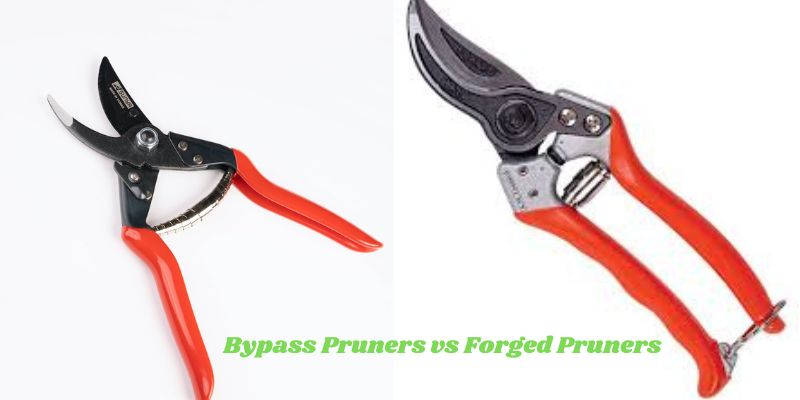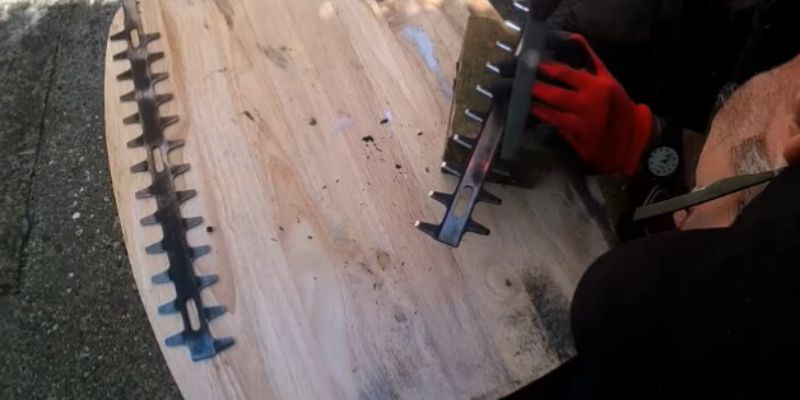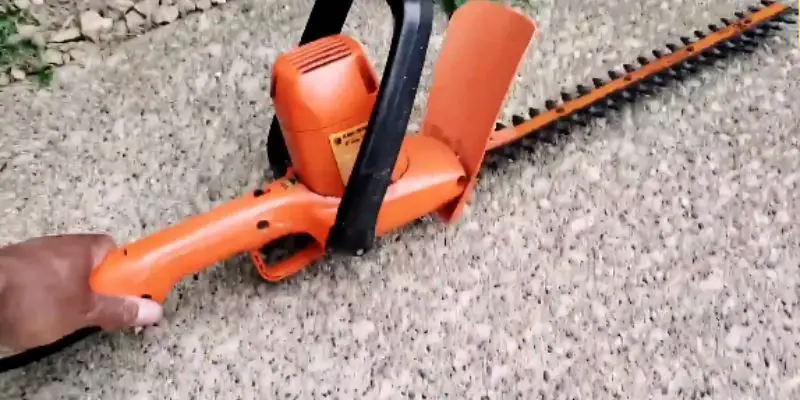While doing gardening and landscaping projects, I’m often asked about the differences between a bypass pruner vs ratchet pruner. Both are very useful tools, but each has distinct strengths that make one better suited for certain pruning jobs over the other.
In this article, I’ll break down the key differences between these two pruner types based on my hands-on experience using them for countless pruning projects over the years. By understanding how they work and where each shines, you can choose the right pruner to efficiently and effectively tackle any pruning task.
What is a Bypass Pruner?
A bypass pruner, also sometimes called an anvil pruner, has two blades – one stationary and one moving. When you squeeze the handles, the moving blade slides past the stationary blade in a scissor-like motion to cut branches. Bypass pruners cut with a clean slicing action, resulting in a smooth cut ideally suited for thinner branches up to about 1/2 inch in diameter.
The bypass action allows for precise cuts just by squeezing the handles. This makes bypass pruners very controllable and great for detailed pruning work where you need to selectively target specific small branches. They also usually feature replaceable and/or sharpenable blades, so they stay sharp for years with proper maintenance.
In my experience, bypass pruners excel for:
- Pruning fine, small-diameter branches on plants, shrubs, and trees
- Shaping hedges and topiary
- Trimming flowers and herbaceous perennials
- Detailing and finishing pruning cuts
- Cutting vines and canes
Their precise scissoring cut allows for clean cuts without damaging surrounding plant material. I rely on high-quality bypass pruners for the majority of my pruning tasks.
What is a Ratchet Pruner?
A ratchet pruner works a bit differently than a bypass pruner. Instead of a sliding cutting action, it uses a lever system and integrated ratchet. Squeezing the handles closes metal jaws lined with serrated teeth. Releasing pressure opens the jaws via a spring.
Ratchet pruners can cut branches up to about 1 inch in diameter. The serrated jaws grip the stem and saw through it with repeated squeezing actions. This sawing motion allows them to cut woody stems that a bypass pruner may have difficulty with.
In my experience using various ratchet pruners in the field, they are best for:
- Pruning thicker branches up to 1-inch diameter
- Cutting tough, woody stems on shrubs like Rose of Sharon and Viburnum
- Trimming canes on raspberry and blackberry plants
- Clearing tangled piles of branches more quickly
- Pruning when hands have limited strength or dexterity
Their gripping teeth and sawing cut make short work of branches that would take longer to slice through with a bypass pruner. Ratcheting through stems is less tiring than many individual bypass cuts when dealing with substantial branches.
Best Uses for Bypass Pruners
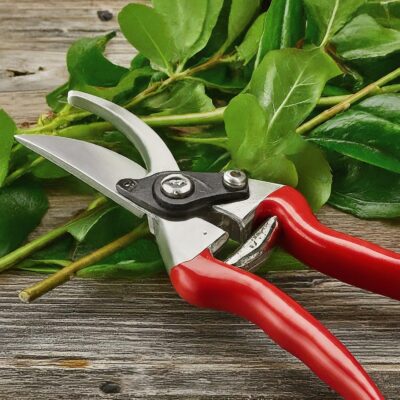
The precision and control of a bypass pruner make it the best choice for detailed pruning jobs where delicacy is important:
Houseplants
The small cuts needed to shape and maintain houseplants are well-suited to the precise scissor action of a bypass pruner. It allows selectivity targeting only the branches you want to remove. I use bypass pruners exclusively for all my indoor plants to avoid any risk of damage to the rest of the plant.
Bonsai Trees
The intensive, artistic pruning and shaping required for bonsai demands extreme precision that only a bypass pruner can provide. Their scissoring cut is smooth and applies minimal pressure, reducing stress on small bonsai branches. Bypass pruners are essential for achieving the intricate formal styles characteristic of bonsai.
Herb Gardens
Whether harvesting individual leaves, pinching back herbaceous growth, or shaping woody herbs, a bypass pruner navigates the close quarters of herb beds with ease. Its control allows trimming just the target stems without disturbing surrounding foliage or plant structure. I always reach for my bypass pruner first when working in the herb garden.
Flower Gardens
Many flowering perennials, annuals, and bulbs grow stems as thin as bonsai or herbaceous plants. A bypass pruner smoothly trims spent blooms, shepherds in new growth, and shapes flowers for continued beauty without damaging delicate parts of the plant. My flower gardens would be a mess without frequent shapings from my trusty bypass pruner.
Greenery in Mixed Containers
The containers on my landscape design clients’ patios and porches usually include multiple plant species in close contact. A bypass pruner is crucial for navigating this intricate spacing and separating individual plants for individualized trims. I can trim each component precisely to highlight its unique character in the design.
Hedges and Topiary
Artistic, formal hedge and topiary shapes demand precise control for repetitive, detailed branch-by-branch sculpting. The smooth, selective cutting of a bypass pruner enables careful targeting of growth points to gradually coax woody materials into intricate geometric forms or animal silhouettes. Whether rounding a boxwood or teasing out a spiral topiary design, the bypass pruner is key.
Best Uses for Ratchet Pruners
While a bypass pruner excels for delicate trims, its limitations become apparent when dealing with thicker, woody material. This is where the ergonomic design and sawing cut of a ratchet pruner prove their worth:
Fruit Trees and Shrubs
The thick canes of raspberry and blackberry patches, as well as branches on fruited trees and shrubs that become woody, are too stiff for a bypass pruner to easily handle. A ratchet pruner’s saw-like jaws make quick work of thicker wood without undue stress on hands or tools. I always use a ratchet pruner for pruning my bramble fruits.
Vines on Arbors or Fences
Woody vines climb up and through latticework, grabbing on with tenacious stems. When it’s time for annual pruning, only a ratchet pruner has the strength to wrestle through these stubborn chunks of lignified plant material. These jobs would be downright miserable without the leverage and sawing capacity of a ratchet pruner.
Larger Shrubs and Yard Trees
While selective branches on shrubs and smaller trees can be snipped with a bypass pruner, whole plant prunings or thicker framework branches require the brawn of a ratchet pruner. Their locking teeth allow thick cuts to be made in sections with repeated squeezes rather than difficult single slices. This reduces hand fatigue during strenuous pruning projects.
Cleanup of Storm Damage
When extreme weather causes tree fall or branch breakage, the tangled piles of extra-stout wood surpass a bypass pruner’s limits. Only a ratchet pruner’s robust design stands up to the demands of bucking up these tougher cuts into more manageable pieces. I always equip myself with ratchet pruners when responding to clients’ tree emergencies caused by storms or other damage.
Rough Edges and Landscape Renovation
Aggressive re-shaping of overgrown shrubs down to hardwood stems is a heavy-duty task well-matched to reliable ratchet pruner power. Their locking teeth stand up to repeated contractions on dense regrowth without binding up. When reining in massive landscape elements down to clean skeletal structures, the ratchet pruner gets the job done efficiently.
Final Thoughts: Which is Best – Bypass Pruner or Ratchet Pruner?
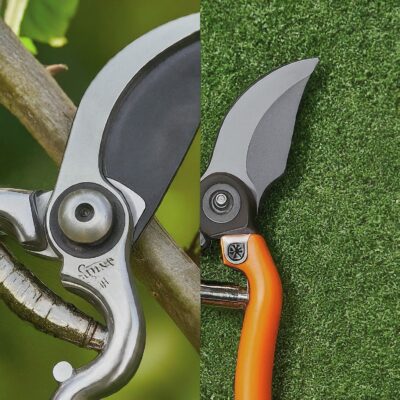
While both tool types have advantages, a wise pruner knows that different situations demand different solutions. Ideally, keep both a high-quality bypass pruner and a ratchet pruner handy to handle any pruning task with the right tool.
For most ordinary in-season shaping and shearing of ornamental plants, flowers, and smaller-scale trees and shrubs, a bypass pruner will likely see the majority of use.
But any project involving excessively thick wood, aggressive pruning back to structural elements, or heavy-duty cleanup will push the limits of even the best bypass pruner. That’s where the all-conquering power of a ratchet pruner proves indispensable.
Over my years of experience, I’ve settled on favoring Felco bypass pruners and Florian ratchet pruners in my pruning toolkit. Other popular brands also offer excellent options. But the most important thing is having both a precision and a power tool available based on the specific needs of the pruning job at hand.
As always in landscape maintenance, the right tool for each unique situation is key to accomplishing timely jobs efficiently and minimizing stress both on pruners’ bodies and plants under care. With practice using both types of pruners, any gardener can expand their skills to tackle all areas of the property with ease.
I hope this detailed breakdown of bypass pruners versus ratchet pruners based on years of hands-on experience has helped clarify which type is preferable for different pruning scenarios. Feel free to contact me if you have any other questions – I’m always happy to share my extensive knowledge to help fellow gardeners select the best pruners for each project. With the right tool in hand, any pruning task becomes that much more manageable.
FAQs on Bypass Pruner vs Ratchet Pruner
What is the difference between a pruner and a bypass pruner?
A bypass pruner is a type of pruner that has two blades – one stationary and one that slides past it when cutting. Regular pruners can cut but work differently.
What is a ratchet pruner used for?
Ratchet pruners are good for cutting thicker branches, around 1 inch thick. The sawing teeth let you cut through woodier material better than regular pruners.
What is the difference between ratchet and bypass secateurs?
Bypass secateurs (another name for bypass pruners) are cut with sliding blades like scissors. Ratchet secateurs have locking teeth that saw through branches thicker than bypass could handle.
What are bypass secateurs used for?
Bypass secateurs are handy for pruning smaller branches and doing detailed shaping work because their scissor cut is very precise.
Why is it called a bypass pruner?
It’s called a bypass pruner because one of the blades bypasses or slides past the other one when cutting, like scissors.
Why would you use a ratchet?
A ratchet’s locking teeth let you see through thicker branches in sections. This comes in handy when you need more strength than a regular pruner provides.

Michael has been in the landscaping world for over 15 years. After obtaining his arborist certification, he dedicated himself to sharing his immense knowledge about plants, trees, and their proper care. Pruning is Michael’s passion. He’s spent decades mastering techniques for timing, methods, and tools. Michael takes great joy in ensuring others learn to maintain beautiful, healthy gardens, and landscapes. Whether through guides, tutorials, or advice, his goal is to equip homeowners and professionals with pruning expertise.
When it comes to choosing the right equipment, Michael is also incredibly knowledgeable. He has used countless pruning tools to discover the most durable, high-quality options. Michael understands what works best in the field. His in-depth comparisons will save you time and money by finding the perfect shears, loppers, trimmers, or saws.
With great respect for horticulture and sustainability, Michael is committed to educating communities. By sharing the insights gained over a lifetime around greenery, he empowers people to steward the planet’s verdant spaces responsibly. Nature is his true passion, and Michael aims to foster others’ love of the living world through his writings.


